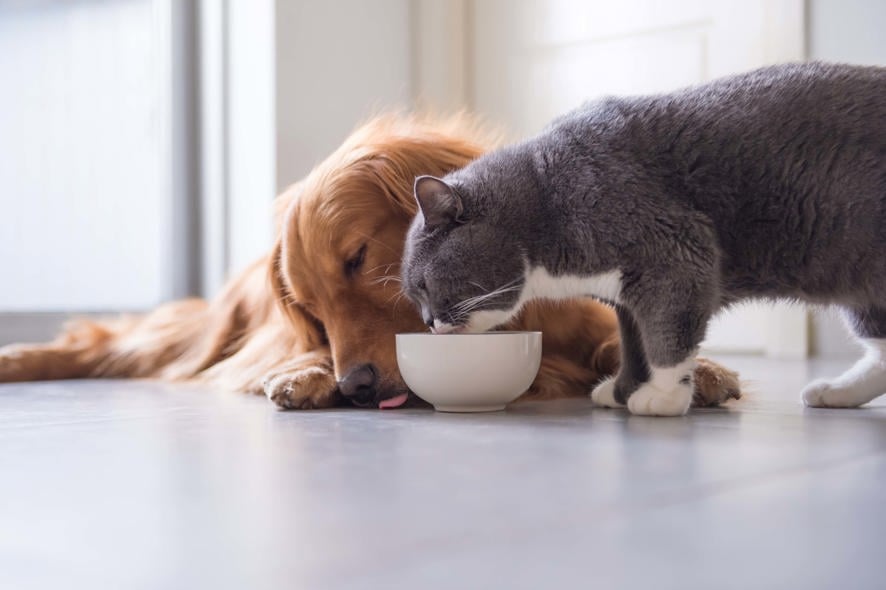Keeping your pet’s food fresh
- Nutrition
- Dog
- Cat
While dry kibble may seem to keep forever, there is a limit to the amount of time it will be safe to be fed. Over time, kibble naturally loses its freshness even while sealed, but this process can be accelerated under certain environmental conditions.
Oxidative rancidity is the damage of fats and oils when exposed to oxygen. It is a natural process that is slowed with the use of antioxidants and is accelerated by the presence of microbiological contamination, heat and ultra violet light. The reaction between fats/oils and oxygen can result in changes to the flavour, aroma and nutritional quality of a product. As the fats and oils are damaged, a reduction will be seen in the energy density and the palatability of the food and the absorption of fat soluble vitamins.

What we do
At Trouw Nutrition, we strive to deliver a fresh, safe and nutritious food for your pet by carefully selecting all the components incorporated in each bag of food: quality ingredients, packaging and antioxidants.
Ingredients: The stress from heat, agitation, air exposure and improper storage can accelerate the oxidation of the ingredients and finished diets. While some heat stress is unavoidable, such as cooking during the formation of kibble and drying to remove moisture, by ensuring adequate ingredient quality and protection with antioxidants helps reduce the impact on the overall diet. We use approved suppliers and closely monitor the quality of ingredients to ensure that fresh, properly protected raw materials are used in our food.
Antioxidants: Specific antioxidants are incorporated into the food during processing to protect the diet from oxidative rancidity. We work in close partnership with our antioxidant supplier to evaluate and test diets to determine the appropriate type and level of these materials in our diets. Natural antioxidants based on mixed tocopherols (Vitamin E) and rosemary are used most commonly in our diets. Antioxidants are not only important for maintaining product freshness but are an important nutrient for your pet, as oxidation in the body damages cells and can contribute to disease.
Packaging: The materials used protect the product from the environment. Designs that ensure package integrity are used to limit the food’s exposure to sunlight and oxygen, protecting the product from oxidative rancidity and ensuring a fresh product at the time of purchase.
What you can do
Pet owners can also positively impact the stability and freshness of their pet’s dry kibble by:
- Storing their food in a cool and dry location, away from sunlight
- Closing the bag top using the closure feature or rolling between servings
- Storing the kibble (in the original packaging) inside a plastic container with a lid*
*Plastic containers are not recommended for storing kibble outside of the packaging, as even small scratches in the plastic provide places where bacteria can grow. As well, plastic containers are difficult to completely clean and remaining rancid fat will contaminate the next fresh kibble you put in the container, accelerating oxidation of the diet. Keeping the original packaging is also important as it contains important information including how to contact the manufacturer, the best before date of the product and the complete lot tracking information.
Sources:
Liang, C. and K.Schwarzer. Comparison of Four Accelerated Stability Methods for Lard and Tallow With and Without Antioxidants. JAOCS. 75(10):1441-1443.
Lin, S., F.Hsieh and H.E. Huff. 1998. Effects of lipids and processing conditions on lipid oxidation of extruded dry pet food during storage. Animal Feed Science and Technology. 71 (3-4):283-294.
Osawa, C.C., L.A.G. Goncalves and S.Ragazzi. 2008. Evaluation of the quality of pet foods using fast techniques and official methods. Ciênc.Tecnol.Aliment.,Campinas. 28(Supl):223-230.
Ragnarsson, J.O. and T.P. Labuza. 1977. Accelerated Shelf-Life Testing for Oxidative Rancidity in Foods – A Review. Fd. Chem. 1977(2): 291-308.
Sinnhuber, R.O. and T.C Yu. 1977. The 2-Thiobarbituric Acid Reaction, an Objective Measure of the Oxidative Deterioration Occurring in Fats and Oils. Journal of Japan Oil Chemists’ Society. 26(5):259-267.
Shermer, W.D. and A.F. Giesen. 1997. Quality control methods to monitor oxidative status of fats: What do fat tests tell you? Feed Management. 48(5):55-58.